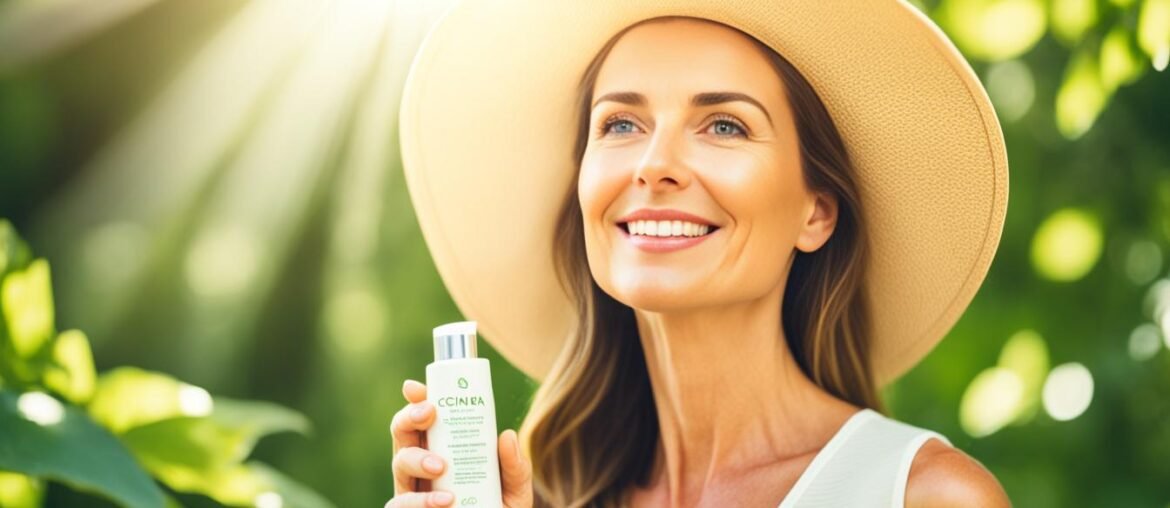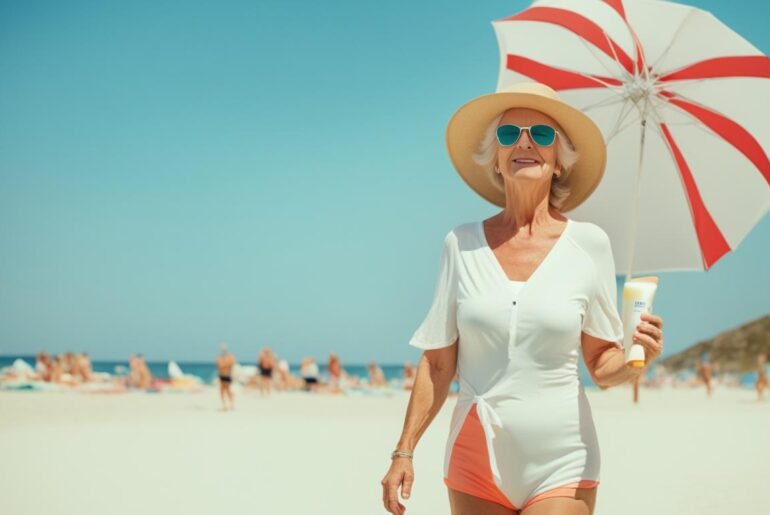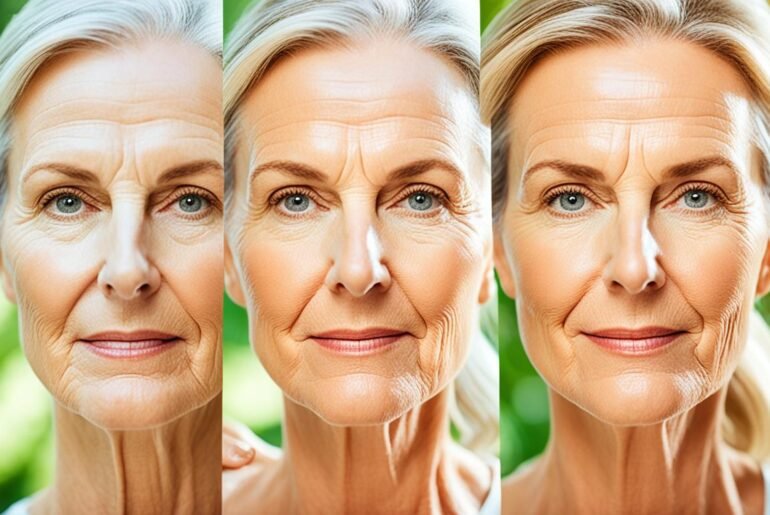Did you know that sun spots, also known as solar lentigines, affect millions of people worldwide, especially those with mature skin? These dark brown patches on the skin can be unsightly and can make individuals feel self-conscious about their appearance. The good news is that there are preventive measures you can take to minimize the formation of sun spots and maintain healthier, more youthful-looking skin.
Key Takeaways:
- Sun spots, also known as solar lentigines, are common in individuals with mature skin.
- Preventing sun spots requires a proactive approach to sun protection and skincare.
- Using serums with antioxidants and applying sunscreen regularly can help prevent sun spots.
- Protective clothing and seeking shade during peak sun hours are essential in preventing sun damage.
- Establishing a daily skincare routine that includes sun protection is crucial for maintaining healthy skin.
Understanding Sunspots and Their Causes
Sun spots, also known as solar lentigines, are flat, tan to dark brown areas of increased pigmentation on sun-exposed skin. They are a common skin concern, particularly among individuals with lighter skin tones. Understanding the causes of sun spots can help in their prevention and effective treatment.
The main cause of sun spots is the overproduction of melanin, which is the natural pigment responsible for the color of our skin. Various factors can trigger melanin overproduction, including:
- UV light damage: Prolonged exposure to the sun’s UV rays stimulates the melanocytes in our skin to produce more melanin. This excessive melanin production leads to the development of sun spots.
- Infrared radiation: Infrared radiation, which is also emitted by the sun, can penetrate deep into the skin and contribute to the overactivation of melanocytes, thereby causing sun spots.
- Pollution: Environmental factors such as pollution can also play a role in the formation of sun spots. Pollutants can trigger oxidative stress in the skin, leading to increased melanin production and the appearance of dark spots.
It’s important to note that certain individuals may be more susceptible to sun spots due to their genetic background and skin characteristics. Those with lighter skin tones generally have less natural protection against UV damage and are more prone to developing sun spots.
To get a better understanding of sun spots and their causes, refer to the following table:
| Cause | Effect on Melanin Production |
|---|---|
| UV light damage | Stimulates melanocytes, leading to increased melanin production |
| Infrared radiation | Activates melanocytes, resulting in excessive melanin synthesis |
| Pollution | Triggers oxidative stress, prompting melanocytes to produce more melanin |
The Importance of Sun Protection for Mature Skin

As we age, our skin becomes more susceptible to sun damage and requires extra attention and care. Mature skin is more prone to developing sun spots and other signs of photoaging, making sun protection an essential part of any skincare routine. Proper sun protection not only prevents sun spots but also helps maintain the overall health and appearance of mature skin.
One of the key components of sun protection for mature skin is the regular use of sunscreen. Sunscreen should be applied daily, even on cloudy days, and reapplied every two hours, especially when spending time outdoors. Look for sunscreens specifically formulated for mature skin, as they often contain additional anti-aging ingredients, such as antioxidants, peptides, and moisturizers. These ingredients can provide added benefits to mature skin, helping to prevent signs of aging caused by sun damage.
Wearing protective clothing is another important aspect of sun protection for mature skin. Opt for lightweight and breathable fabrics that cover exposed areas, such as long-sleeved shirts, wide-brimmed hats, and UV-blocking sunglasses. Seeking shade during peak sun hours, typically between 10 a.m. and 2 p.m., further reduces exposure to harmful UV rays, minimizing the risk of sun damage and age spots.
It is important to note that sun protection is not only about preventing sun spots but also about maintaining the overall health and youthfulness of the skin. Regularly using sunscreen and taking other sun protection measures can help prevent other signs of photoaging, such as wrinkles, fine lines, and uneven skin tone.
Incorporating sun protection into your daily skincare routine is a crucial step in caring for mature skin. By investing in quality sunscreens, wearing protective clothing, and seeking shade when necessary, you can significantly reduce the risk of sun damage and maintain healthy, radiant skin. Remember, prevention is key when it comes to mature skin sun protection!
| Sunscreen Brand | SPF | Key Features |
|---|---|---|
| Aveeno Positively Radiant Daily Moisturizer | 30 | Contains Total Soy Complex for brightening and moisture retention |
| La Roche-Posay Anthelios Melt-In Sunscreen Milk | 50 | Non-greasy formula with advanced protection against UVA and UVB rays |
| Neutrogena Age Shield Face Lotion Sunscreen | 110 | High SPF for maximum protection, oil-free and non-comedogenic |
| CeraVe Hydrating Sunscreen | 30 | Contains ceramides and hyaluronic acid for intense hydration |
Recommended Serums for Sun Spot Prevention
Serums containing antioxidants, such as vitamin C, can help prevent sun spots by protecting the skin from free-radical damage caused by UV light. These serums are designed to provide an extra layer of defense against the harmful effects of sun exposure, reduce the appearance of existing sun spots, and promote a more even skin tone.
Here are some highly recommended serums for sun spot prevention:
| Serum | Brand |
|---|---|
| Aveeno Positively Radiant Overnight Hydrating Facial | Aveeno |
| Vichy LiftActiv Vitamin C Serum | Vichy |
| SkinCeuticals CE Ferulic | SkinCeuticals |
| La Roche-Posay Anthelios AOX Daily Antioxidant Serum | La Roche-Posay |
| Supergoop! City Sunscreen Serum | Supergoop! |
These serums are formulated with potent antioxidants that not only help protect the skin from sun damage but also provide additional benefits such as brightening the complexion and boosting collagen production. Incorporating these serums into your skincare routine can be an effective way to prevent sun spots and maintain a youthful-looking complexion.
Remember, in addition to using these serums, it is crucial to practice other sun spot prevention tips such as wearing broad-spectrum sunscreen, seeking shade, and avoiding excessive sun exposure, especially during peak hours.
Tips for Applying Sunscreen Effectively
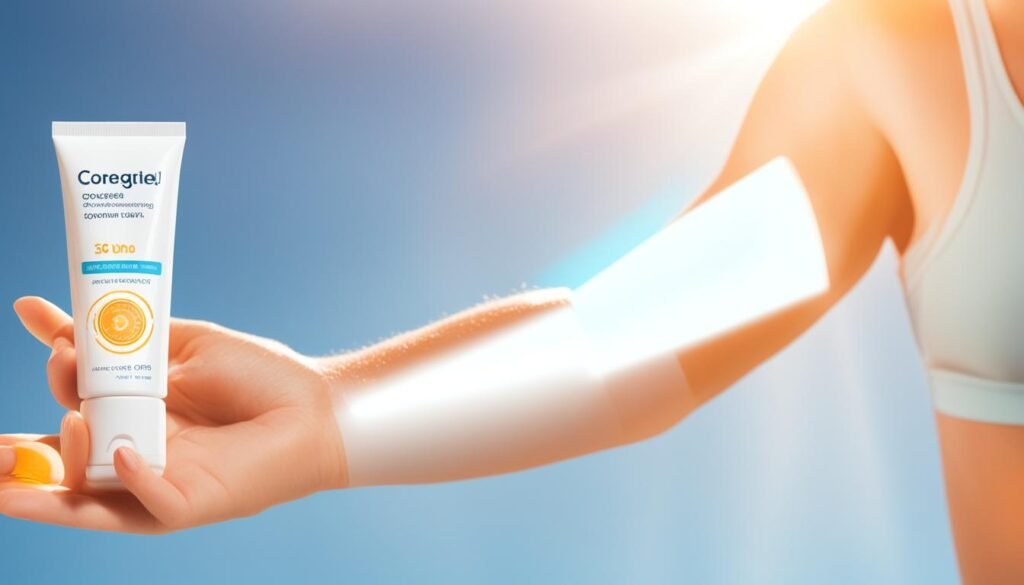
Proper application of sunscreen is essential for effective sun protection. To ensure maximum benefits, follow these sunscreen application tips and sun protection best practices:
- Apply sunscreen at least 15 to 30 minutes before sun exposure. This allows the sunscreen to fully absorb into the skin and provide optimal protection.
- Reapply sunscreen every two hours, or more often if swimming or perspiring heavily. Regular reapplication is necessary to maintain the sunscreen’s effectiveness.
- Use a broad-spectrum sunscreen that protects against both UVA and UVB rays. Look for a sun protection factor (SPF) of at least 30 to ensure sufficient protection.
- Cover all exposed areas of the skin with sunscreen, including the face, neck, arms, legs, and any other areas that are not protected by clothing.
- Don’t forget to apply sunscreen to often overlooked areas, such as the ears, back of the neck, and the tops of the feet.
- When applying sunscreen to the face, be gentle and avoid rubbing or stretching the skin. Use a gentle patting motion to ensure even coverage.
- If you have sensitive or acne-prone skin, choose a sunscreen that is labeled as non-comedogenic and oil-free to minimize the risk of breakouts.
- Aside from sunscreen, consider wearing protective clothing, such as wide-brimmed hats, long-sleeved shirts, and sunglasses, to further shield your skin from the sun’s harmful rays.
- Seek shade whenever possible, especially during the peak sun hours between 10 a.m. and 4 p.m.
By following these sunscreen application tips and sun protection best practices, you can ensure that your skin is well-protected from the damaging effects of the sun.
Understanding Age Spots and Their Characteristics
Age spots, also known as solar lentigines, are small, flat dark areas on the skin that typically appear on sun-exposed areas such as the face, hands, shoulders, and arms. They are more common in adults over the age of 50 but can also occur in younger individuals with significant sun exposure.
Age spots are usually tan to dark brown in color and can range in size from freckle-sized to about 1/2 inch across. Unlike freckles, age spots do not fade and may actually increase in size and group together over time.
These spots are caused by the skin’s overproduction of melanin, the natural pigment that gives color to the skin. When the skin is exposed to UV light, infrared radiation, or pollution, it triggers the production of extra melanin, resulting in the formation of age spots.
While age spots are generally harmless, they can be a cosmetic concern for some individuals. If you are looking to lighten or remove age spots, there are various treatment options available, including topical creams, laser therapy, cryotherapy, and chemical peels. It is recommended to consult with a dermatologist to determine the most suitable treatment option for your individual needs.
To get a better idea of how age spots look like and their distinctive characteristics, refer to the image below:
Using sunscreen and practicing sun protection measures can help prevent the formation of age spots. It is important to apply a broad-spectrum sunscreen with at least SPF 30 and reapply it regularly, especially when spending time outdoors. Wearing protective clothing, sunglasses, and seeking shade during peak sun hours can also minimize the risk of age spots.
Treating and Lightening Age Spots
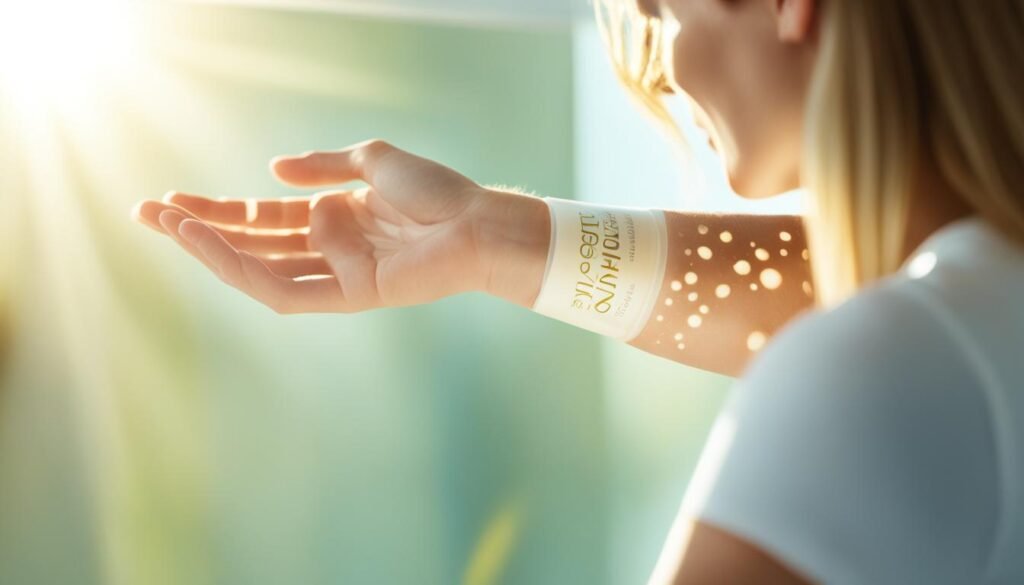
Age spots, also known as solar lentigines, are a common concern for many individuals, especially those with mature skin. While age spots do not require medical treatment, they can be lightened or removed for cosmetic reasons. There are several treatment options available that can help diminish the appearance of age spots and restore a more even skin tone.
1. Topical Creams: Topical creams containing ingredients such as hydroquinone or other lightening agents can help fade age spots over time. These creams work by inhibiting the production of melanin, the pigment responsible for the darkening of the skin.
2. Laser Therapy: Laser therapy is a non-invasive treatment technique that targets the pigment in age spots, breaking it down without causing damage to the surrounding skin. This treatment option can effectively lighten age spots and improve overall skin texture.
3. Cryotherapy: Cryotherapy involves freezing the age spots with liquid nitrogen. This freezing process causes the spots to darken and eventually peel off, revealing lighter, unblemished skin underneath.
4. Chemical Peels: Chemical peels use a chemical solution to exfoliate the top layer of the skin, promoting cell turnover and reducing the appearance of age spots. This treatment option can also help improve skin texture and tone.
It is important to note that the effectiveness of these treatments may vary depending on individual factors such as the severity of the age spots and skin type. It is recommended to consult with a dermatologist to determine the most suitable treatment option based on your specific needs and skin condition.
Expert Tip:
Consistency is key when it comes to treating age spots. Whether you opt for topical creams or professional treatments, following a regular skincare routine and diligently applying sunscreen can help maintain the results and prevent new age spots from forming.
Tips for Preventing Age Spots
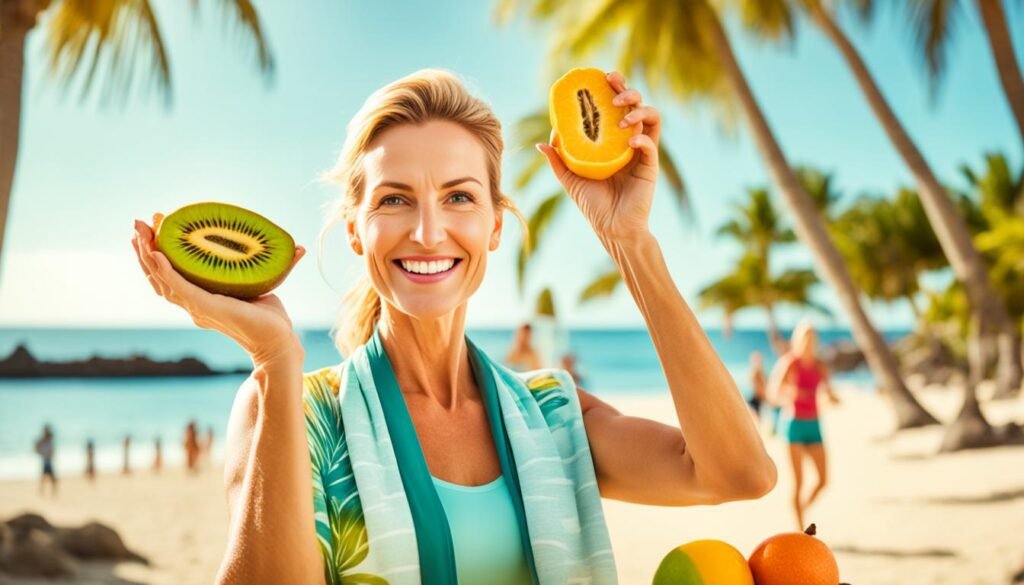
To help prevent age spots, it is important to take precautions to minimize sun exposure and protect the skin from harmful UV radiation. By following these age spot prevention tips, you can maintain healthier, more youthful-looking skin:
- Limit Sun Exposure: Avoid spending extended periods in the sun, especially between 10 a.m. and 2 p.m., when the sun’s rays are the strongest.
- Wear Protective Clothing: Cover your skin with clothing that offers sun protection, such as long sleeves, wide-brimmed hats, and UV-blocking sunglasses.
- Apply Broad-Spectrum Sunscreen: Regularly apply a broad-spectrum sunscreen with a minimum SPF of 30 to all exposed areas of your skin. Reapply every two hours or more frequently if swimming or perspiring.
- Avoid Tanning Beds: Tanning beds emit harmful UV radiation, which can increase the risk of age spots and other sun damage. It’s best to avoid them altogether.
- Establish a Daily Skincare Routine: Incorporate a daily skincare routine that includes cleansing, moisturizing, and applying sunscreen. Consistency is key.
By following these age spot prevention tips and incorporating sun protection into your daily routine, you can significantly reduce the risk of developing age spots and maintain the health and appearance of your skin.
| Sun Exposure Precautions | Benefits |
|---|---|
| Limiting sun exposure | – Reduces the risk of age spots – Minimizes the harmful effects of UV radiation – Preserves the health and youthfulness of the skin |
| Wearing protective clothing | – Provides physical barrier against UV rays – Prevents direct sun exposure – Shields the skin from damage |
| Applying broad-spectrum sunscreen | – Protects the skin against UVA and UVB rays – Prevents sunburn and sun damage – Keeps the skin healthy and radiant |
| Avoiding tanning beds | – Reduces the risk of UV-induced skin damage – Limits exposure to harmful radiation – Preserves the skin’s natural beauty |
| Establishing a daily skincare routine | – Maintains the overall health of the skin – Supports the skin’s natural defense mechanisms – Promotes a youthful and vibrant complexion |
Photoaging and its Effects on the Skin
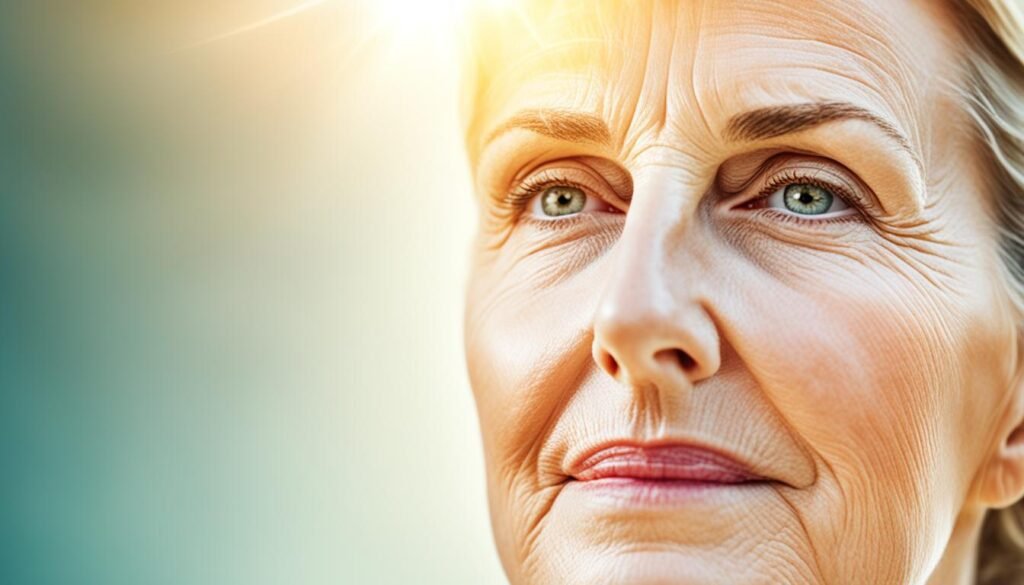
Photoaging is a term used to describe the premature aging of the skin caused by continuous exposure to UV radiation from the sun or artificial sources such as tanning beds. This persistent exposure to harmful rays can have various detrimental effects on the skin, resulting in premature skin aging.
Effects of photoaging include:
- Wrinkles and fine lines: Photoaging can lead to the development of wrinkles and fine lines, making the skin appear older and less youthful.
- Age spots: Increased pigmentation and the formation of age spots are common consequences of photoaging.
- Uneven skin texture: Photoaging can cause the skin to become rough and uneven in texture, further contributing to an aged appearance.
- Loss of elasticity: The collagen and elastin fibers in the skin break down faster due to photoaging, resulting in a loss of skin firmness and elasticity.
- Risk of skin cancer: Prolonged exposure to UV radiation can significantly increase the risk of developing skin cancer.
It is important to note that photoaging can lead to premature skin aging, which means the skin may appear aged beyond its chronological age. To minimize the effects of photoaging, it is crucial to take preventive measures and adopt a comprehensive skincare regimen that focuses on sun protection and anti-aging strategies.
Preventive Measures for Minimizing Photoaging Effects
Preventing photoaging involves incorporating the following practices into your skincare routine:
- Apply a broad-spectrum sunscreen with a high SPF regularly and generously to protect the skin from harmful UV rays.
- Wear protective clothing, such as wide-brimmed hats and long sleeves, to shield the skin from direct sun exposure.
- Seek shade whenever possible, especially during peak sun hours when UV radiation is the strongest.
- Avoid using tanning beds or other artificial sources of UV light.
- Use skincare products with antioxidants, such as vitamin C, to combat the oxidative damage caused by UV radiation.
- Maintain a healthy lifestyle by eating a balanced diet, exercising regularly, and getting enough sleep to support overall skin health.
By implementing these preventive measures and adopting a holistic approach to skincare, you can effectively minimize the effects of photoaging and maintain healthier, more youthful-looking skin.
Protecting Skin from Photoaging

Preventing photoaging is essential for maintaining healthy, youthful-looking skin. By adopting a comprehensive approach to sun protection and incorporating skincare practices that target the effects of UV radiation, you can safeguard your skin from premature aging and damage caused by sun exposure.
Here are some sun protection practices to help shield your skin from photoaging:
- Avoid excessive sun exposure: Limit your time in the sun, especially between 10 a.m. and 4 p.m., when the sun’s rays are strongest.
- Use broad-spectrum sunscreen: Apply a sunscreen with a high sun protection factor (SPF) of 30 or above. Ensure that it offers protection against both UVA and UVB rays.
- Wear protective clothing and accessories: Cover your skin with long-sleeved shirts, pants, wide-brimmed hats, and UV-blocking sunglasses.
- Seek shade: When outdoors, seek shade under trees, umbrellas, or other forms of shelter to reduce direct sun exposure.
- Avoid artificial UV light sources: Steer clear of tanning beds, as they emit artificial UV radiation that can contribute to photoaging.
In addition to these sun protection practices, incorporating skincare products that contain antioxidants and anti-aging ingredients can further support your skin’s defense against photoaging. Antioxidants help neutralize free radicals caused by UV radiation, while anti-aging ingredients promote skin renewal and elasticity.
To protect your skin from photoaging, choose skincare products that offer a potent blend of antioxidants, such as vitamin C, resveratrol, or green tea extract. Look for serums or moisturizers that specifically target the signs of aging and provide added protection against harmful UV rays.
By following these sun protection practices and incorporating effective skincare products into your daily routine, you can significantly reduce the risk of photoaging and maintain healthier, more resilient skin.
Risk Factors for Sun-Damaged Skin
When it comes to sun-damaged skin, certain risk factors can increase susceptibility to harmful effects. Understanding these risk factors is essential for individuals aiming to protect their skin from sun damage and maintain long-term skin health.
Light Skin Tone
Individuals with a lighter skin tone are generally more susceptible to sun damage. The lower level of melanin in lighter skin provides less natural protection against harmful UV radiation from the sun. It is important for those with lighter skin tones to take extra precautions to minimize sun exposure and use adequate sun protection measures.
History of Frequent or Intense Sun Exposure or Sunburn
Repeated or intense sun exposure, as well as a history of sunburns, can significantly increase the risk of sun-damaged skin. Prolonged and unprotected exposure to the sun’s UV rays can cause long-term damage, such as the development of sun spots, premature aging, and an increased risk of skin cancer.
Family History of Skin Cancer
Having a family history of skin cancer can make individuals more susceptible to sun damage. It is important to be aware of any family history of skin cancer and take proactive measures to protect the skin and undergo regular screenings for early detection of potential skin abnormalities.
Moles and Eye/Hair Color
Having many moles or specific eye and hair colors can also contribute to an increased risk of sun-damaged skin. Blue or green colored eyes, as well as blond, red, or light brown hair, are often associated with a higher susceptibility to sun damage. Additionally, individuals with numerous moles should be cautious and monitor them regularly for any changes.
Medical Conditions and Medications
Certain medical conditions, such as autoimmune diseases, can make the skin more vulnerable to sun damage. Likewise, individuals who have undergone organ transplantations or take medications that increase skin sensitivity to sunlight should exercise additional caution and take necessary sun protection measures.
By understanding the risk factors associated with sun-damaged skin, individuals can take proactive steps to protect themselves from harmful effects. Whether it is adopting a consistent sun protection routine, seeking shade during peak sun hours, or using appropriate skincare products, prevention is key in maintaining healthy, radiant skin.
Conclusion
Preventing sun spots and photoaging is paramount for maintaining healthy skin. By adopting a proactive and consistent approach to sun protection and skincare, individuals can reduce the risk of sun damage and achieve a more youthful appearance.
The first step in sun spot prevention is minimizing sun exposure. This involves seeking shade during peak sun hours, wearing protective clothing, and using a broad-spectrum sunscreen with a high SPF. Regular and proper application of sunscreen is crucial, reapplying every two hours or more frequently when swimming or perspiring.
Incorporating antioxidant-rich serums into your skincare routine can provide additional protection against sun spots and photoaging. Look for serums containing vitamin C, which is known for its ability to neutralize free radicals and promote skin health. By combining these preventive measures, individuals can maintain healthier, more resilient skin as they age.
FAQ
Can sun spots be prevented on mature skin?
Yes, sun spots can be prevented on mature skin through proper sun protection measures and skincare routines.
What causes sun spots on the skin?
Sun spots are caused by the skin’s overproduction of melanin due to exposure to UV light, infrared radiation, and pollution.
Why is sun protection important for mature skin?
Sun protection is crucial for mature skin to prevent sun damage and the formation of sun spots, as well as to maintain overall skin health.
Are there any recommended serums for sun spot prevention?
Yes, serums containing antioxidants, such as vitamin C, can help prevent sun spots. Some recommended serums include Aveeno Positively Radiant Overnight Hydrating Facial, Vichy LiftActiv Vitamin C Serum, and SkinCeuticals CE Ferulic.
What are some tips for applying sunscreen effectively?
It is important to apply sunscreen at least 15 to 30 minutes before sun exposure and to reapply every two hours or more often if swimming or perspiring. Use a broad-spectrum sunscreen with at least SPF 30 and cover all exposed areas of the skin. Seek shade and wear protective clothing for additional sun protection.
What are age spots and how can they be treated?
Age spots, also known as solar lentigines, are small, dark areas on the skin caused by sun exposure. They can be treated with topical creams, laser therapy, cryotherapy, or chemical peels.
How can age spots be prevented?
Age spots can be prevented by minimizing sun exposure, wearing sunscreen with at least SPF 30, and establishing a daily skincare routine that includes sun protection.
What is photoaging and how can it affect the skin?
Photoaging refers to premature skin aging caused by UV radiation. It can cause wrinkles, age spots, uneven skin texture, and loss of elasticity.
How can the skin be protected from photoaging?
The skin can be protected from photoaging by avoiding excessive sun exposure, using broad-spectrum sunscreen, wearing protective clothing, seeking shade, and avoiding artificial UV light sources.
Who is at a higher risk for sun-damaged skin?
Individuals with lighter skin tones, a history of frequent sun exposure, a family history of skin cancer, and certain medical conditions or medications that increase sensitivity to sunlight are at a higher risk for sun-damaged skin.
What is the key to preventing sun spots and maintaining healthy skin?
The key to preventing sun spots and maintaining healthy skin is implementing consistent sun protection measures and adopting a comprehensive skincare routine that includes products with antioxidants and anti-aging ingredients.

